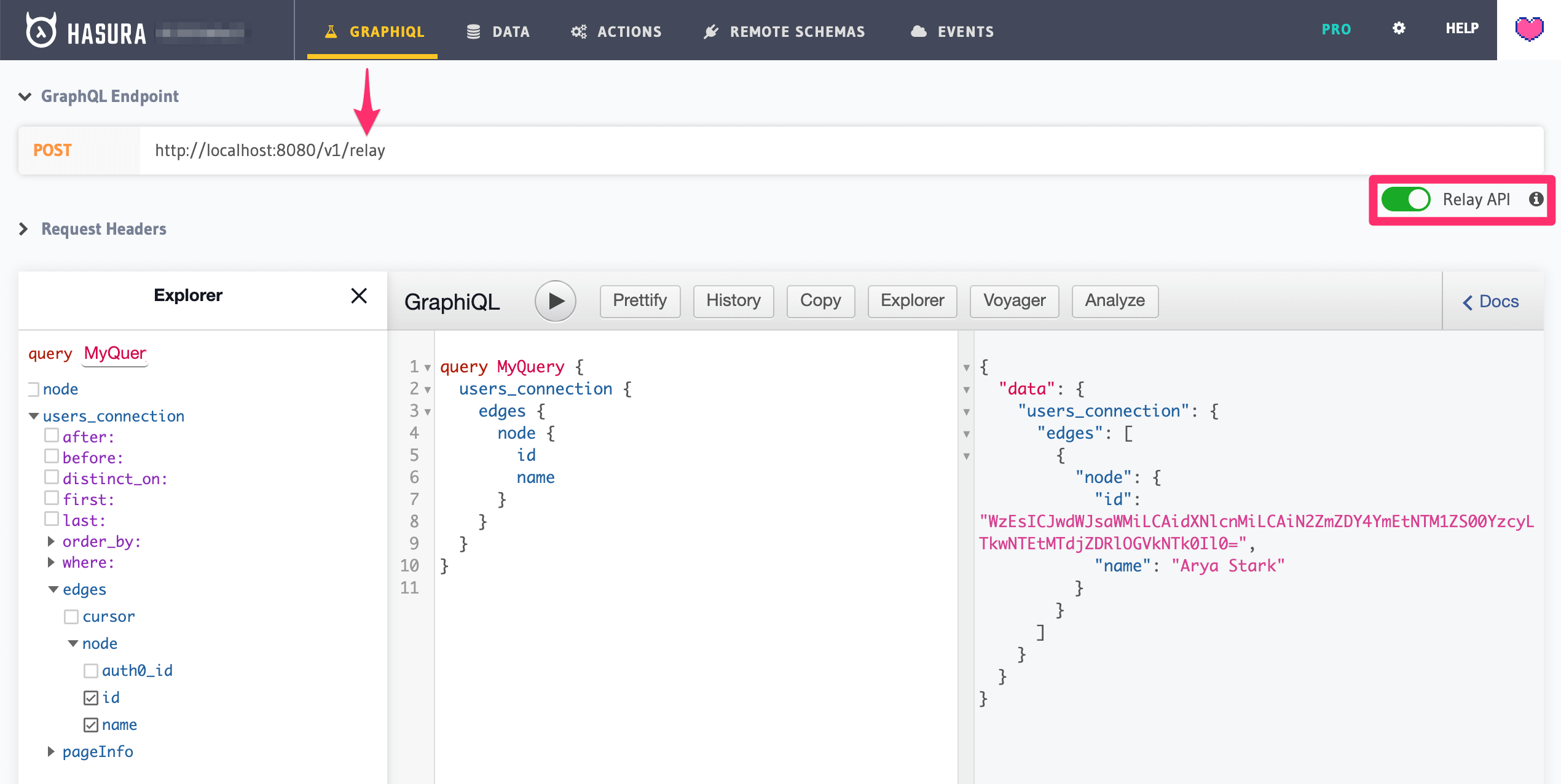Postgres: Relay Schema
Introduction
The Hasura GraphQL engine serves a Relay schema for Postgres tables which have a primary key
defined. The Relay schema can be accessed through the /v1beta1/relay endpoint.

Relay is supported from versions v1.3.0 and above.
What is Relay?
Relay is an opinionated JavaScript framework for declaratively fetching and managing GraphQL data. Relay's strength lies in how it removes opportunities for developer errors, by providing conventions that result in performant and type-safe apps.
While using Relay saves you work on the client side with tasks like pagination, using Relay and Hasura together saves you even more work, because Hasura automatically sets up the Relay backend for you on top of your database.
Benefits of Relay
Relay's client-side benefits include:
- Colocation: By convention, GraphQL fragments are colocated with their views, so that each component describes
exactly what data it needs. This declarative approach has several benefits:
- It's hard to over-fetch data (which would hurt performance), or under-fetch data (which might cause errors).
- Components can only access data they've asked for. This data masking prevents implicit data dependency bugs.
- Components only re-render when the exact data they're using is updated, preventing unnecessary re-renders.
- Performance: The Relay compiler composes your GraphQL fragments into optimized and efficient batches to reduce round-trips to the server. The compiler also applies transforms to your queries to remove redundancies and shorten query strings, which reduces upload bytes.
- Strong typing: The compiler automatically generates Flow (or TypeScript) types, which you can import into your component for type checking in your code editor and during build time.
To learn more about these and other Relay features, like persisted queries, local state management, passing arguments to fragments, and fetching data as early as possible, check out the Relay docs.
For a more detailed breakdown of Relay and its benefits, check out our deep-dive on Relay.
Relay's server spec
To support the above client-side benefits, Relay has a particular server specification.
Hasura's Relay API sets up this spec for you automatically, so you don't have to implement it manually.
According to the spec, the server must provide:
- A mechanism for refetching an object: The convention is a Node interface with a globally unique
idfield, as well as a root field callednode, which allows fetching data by thisid. This is great for performance on the client side, but hard to implement on the server side, since you have to make sureid's are globally unique, objects can be re-fetched via theirid's, etc. - A description of how to page through connections: Connections are Relay's way of standardizing pagination. They allow us to communicate more info between the client and the server, such as cursors and page info, so that we can paginate in a predictable pattern. On the client side, Relay saves you a ton of work by keeping track of the moving parts of pagination and merging results automatically.
Check out this example repo to see how to set up pagination with Hasura and Relay.
Node interface
The Node interface in the Relay schema has exactly one field which returns a non-null ID value. Each table object
type in the Relay schema should implement the Node interface to provide
global object identification.
To identify each row in a table, the id field value is encoded with table information (schema and name) and primary
key column values. The GraphQL engine uses base64 encoded JSON string and the JSON schema looks as follows:
[<version-integer>, "<table-schema>", "<table-name>", "column-1", "column-2", ... "column-n"]
version-integer: The JSON schema version (the current version is1). This is to enable any backward compatibility if the JSON representation has to change.table-schema: The table's schema.table-name: The table's name.column-1..column-n: The primary key column values. The order is Postgres dependent.
The same base64 encoded JSON string is accepted for the root node field resolver's id input.
Example
For the author table in the public schema whose primary key column is author_id, of type uuid.
[1, "public", "author", "296d30b1-474d-4011-a907-2701992b04c1"]
And base64 encoded value is
WzEsICJwdWJsaWMiLCAiYXV0aG9yIiwgIjI5NmQzMGIxLTQ3NGQtNDAxMS1hOTA3LTI3MDE5OTJiMDRjMSJd
Exporting the Relay schema
You can export the Relay schema in the same way as you can
export the GraphQL schema. But instead of the GraphQL endpoint, you
can specify the Relay endpoint, which will end in /v1beta1/relay.
Limitations
At this time, Hasura's Relay implementation only supports Postgres tables with a primary key defined, and custom SQL functions whose returning table has a primary key defined.
Persisted queries will be supported soon.
Currently, Hasura's Relay schema doesn't expose remote schemas or actions. This will be fixed in future releases.

